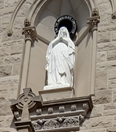Receiving (not taking) Communion: Difference between revisions
No edit summary |
No edit summary |
||
| Line 2: | Line 2: | ||
In Catholic terminology and practice one "receives" and does not "take" Holy Communion. The Holy Eucharist, i.e., the Body and Blood of Christ, are "distributed" by a Eucharistic Minister (a priest, deacon, or "extraordinary minister"). | In Catholic terminology and practice one "receives" and does not "take" Holy Communion. The Holy Eucharist, i.e., the Body and Blood of Christ, are "distributed" by a Eucharistic Minister (a priest, deacon, or "extraordinary minister"). | ||
For an analysis of the difference between the incorrect "take Communion" and proper "recieve Communion, see [[Blog:Recieving (not taking) Communion]] | |||
Revision as of 12:38, 13 May 2024
The Rite of Communion is the summation of the Liturgy of the Eucharist in which the failthful receive the bread and wine as the Body and Blood of Christ. Here for a discussion about Holy Communion and transfiguration.
In Catholic terminology and practice one "receives" and does not "take" Holy Communion. The Holy Eucharist, i.e., the Body and Blood of Christ, are "distributed" by a Eucharistic Minister (a priest, deacon, or "extraordinary minister").
For an analysis of the difference between the incorrect "take Communion" and proper "recieve Communion, see Blog:Recieving (not taking) Communion
